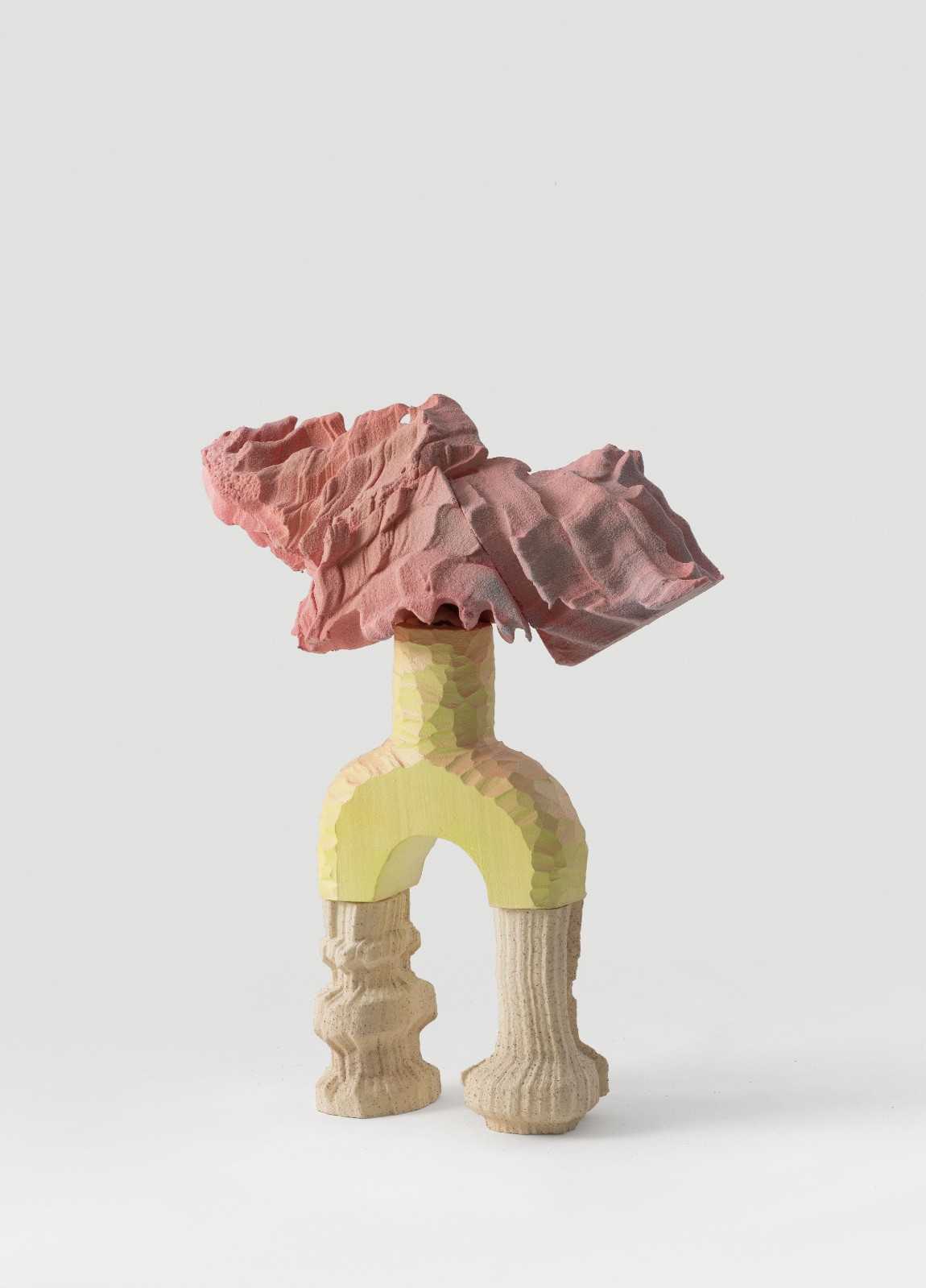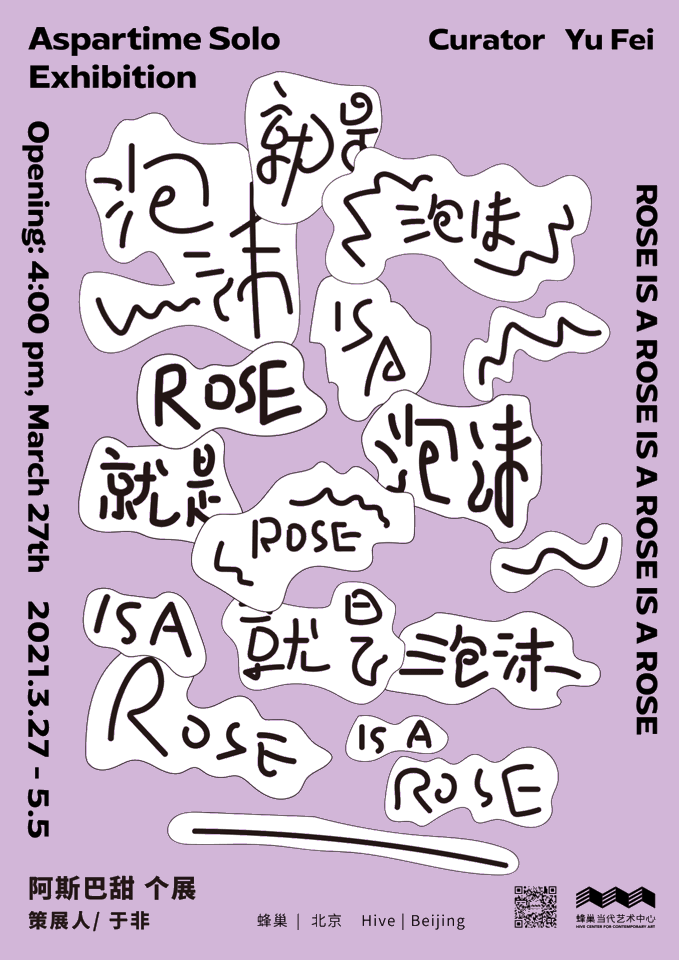JIAHUA VISION
Curator: Zhao Xiaodan
To perceive marvels, an artist needs to spend much time arousing inner imagination and narrative potential, hence a stray state of body and soul that travel freely in certain self-developed logic. This process might echo what Alexander Pope wrote in An Essay on Man:
Go, wondrous creature! mount where science guides;
Go, measure earth, weigh air, and state the tides;
Instruct the planets in what orbs to run;
Correct old time, and regulate the sun;
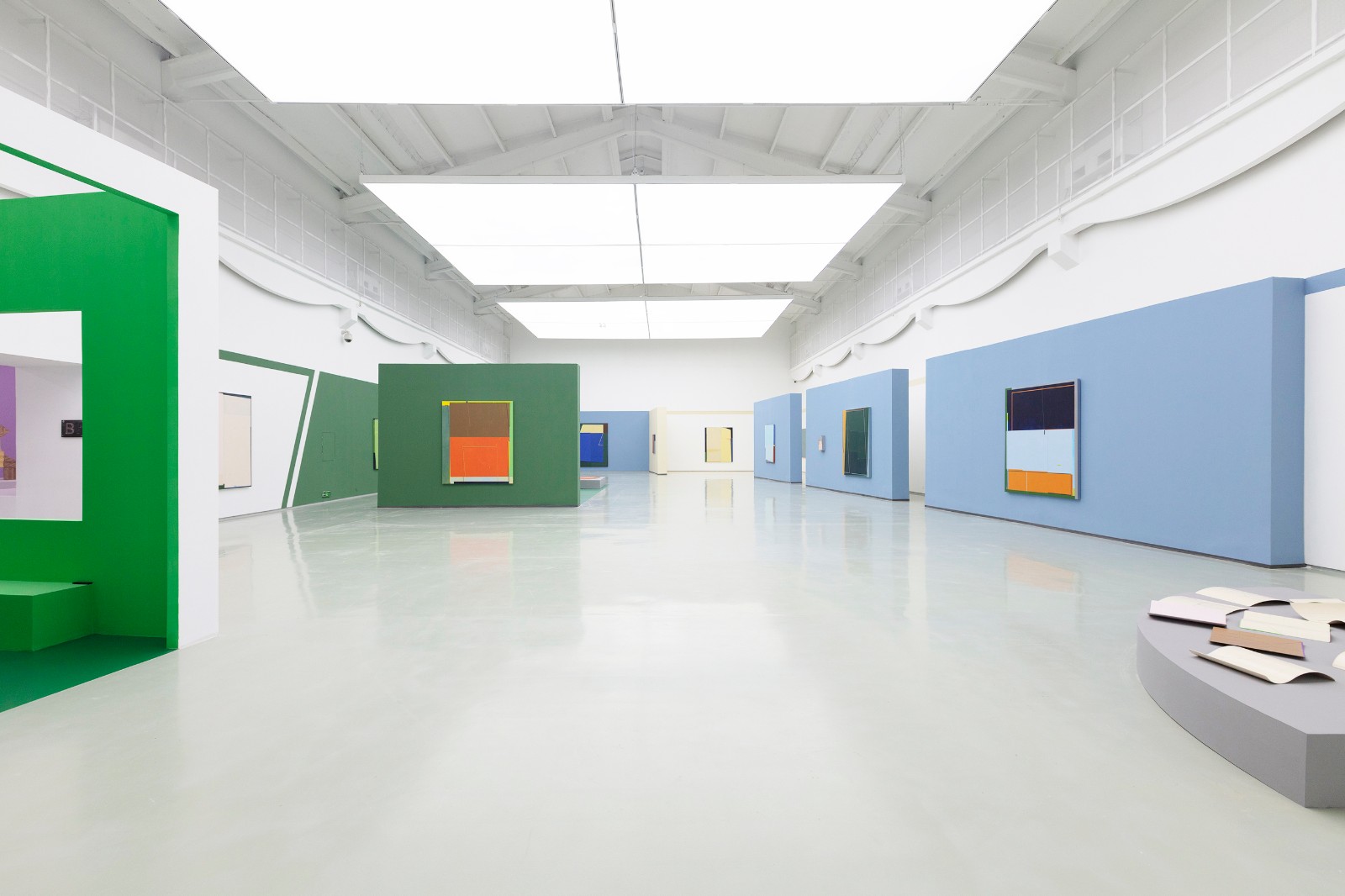
Exhibition View of "JIAHUA VISION"
Based on the logic of artistic creation, what attracts artists more is not to observe macroscopically the shifts and migration of the world order, but to explore whether the rete mirabile found in the giraffe’s brain, which regulates the blood pressure and genetically foresees a long neck before the giraffe has evolved, exists in the human brain as well. What makes Qian Jiahua unique is that she paints depending on the intuition experienced in the art and the creative desire aroused by some specific environment. She introduces free imagination into her creation without losing her style and her true feelings for objects, which is a very tough process. To bring on the symbiotic synesthesia of the inner body, the artist has to return to innocence and purity, expecting some transcendence of personal inner experience and the improvement of abilities. She synchronizes the growth of her scientific knowledge with the outward extension and the inward excavation of her personal experience, takes in some information from external sources, and exudes the traces of her thinking on a two-dimensional plane. New shapes and new messages in the work that are different from the sources are playing with amazing lines, colors, blocks and rhythms. In the latent-structure narrative that compares with, couples with, interlaces with, undoes, depletes and reconstructs real things, the infinite possibilities of these images are being staged in turn, where simultaneously an artist’s views of abstract art come into being bit by bit.
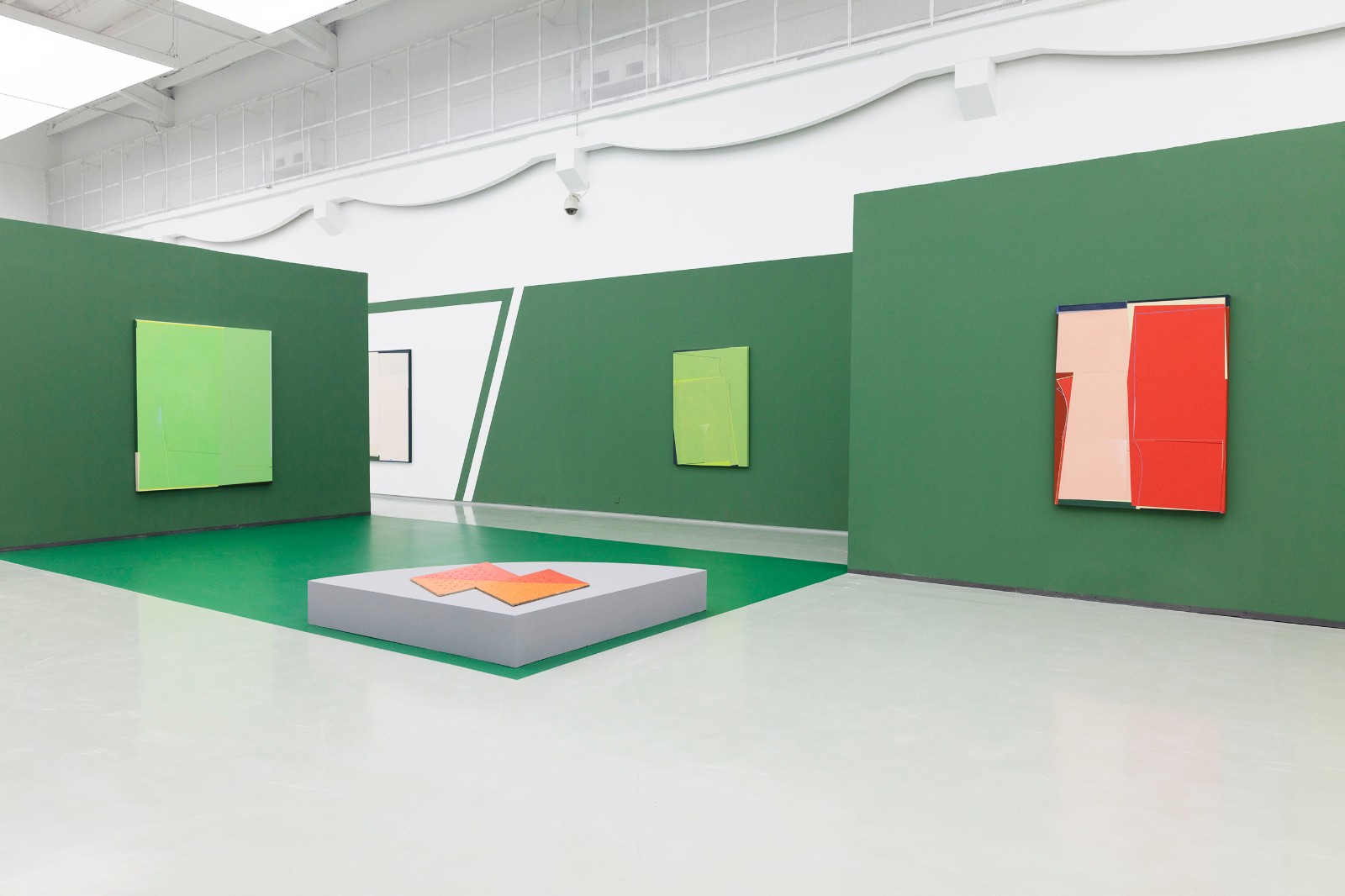
Exhibition View of "JIAHUA VISION"
From the earliest games of strokes to the dominant charming sky in the frame, and to the noisy city as a result of migration for living conditions, what the artist sees ahead is variable artificial scenery. The natural scenery is solely revealed from the cramped high-rise crevices. The contemplation of one's existence coincides with the pure aesthetic of the real world. For this reason, the smoothly colored sky in the picture has gradually turned into particular textures featuring realistic elements: courier cartons, bubble wrap, canvas shades on a highway truck next to the studio...seemingly a modernological study on modern commodity transport. Vision occurs when the artist’s new thinking logic starts to blossom. Once the new experience attempts to intrude on its existing logic, how should the elements of the new world be grasped? Distorted romance and surging waves of reality are feverishly trying to occupy the system that still scatters the faint light of utopia and ivory towers. Is an artist logically able to make the reality stagnate, like Wanda, and to carefully differentiate the artificial space full of dislocations, faults and shelters? The above explains the origin of the English title, Jiahua Vision.
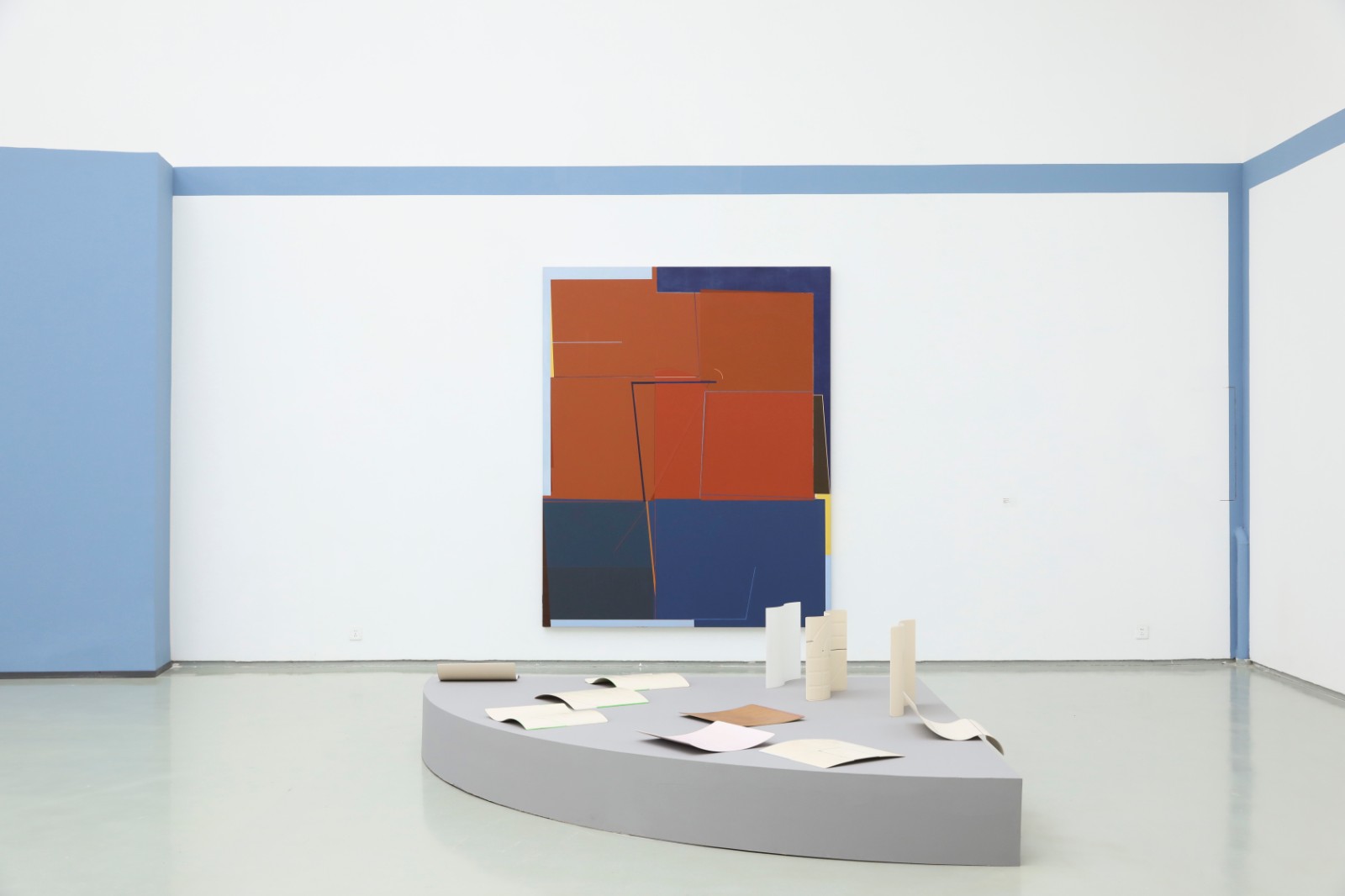
Exhibition View of "JIAHUA VISION"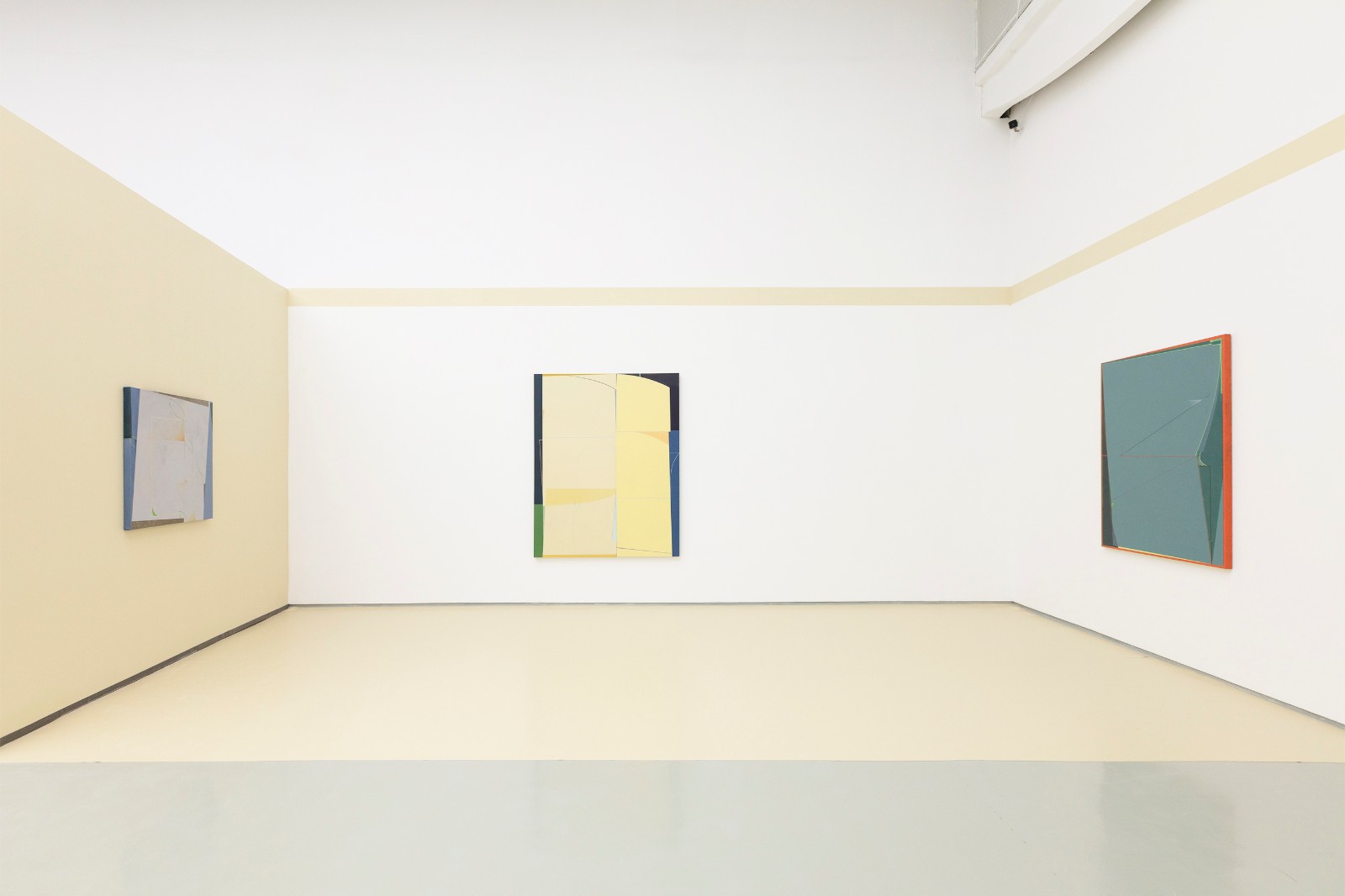 Exhibition View of "JIAHUA VISION"
Exhibition View of "JIAHUA VISION"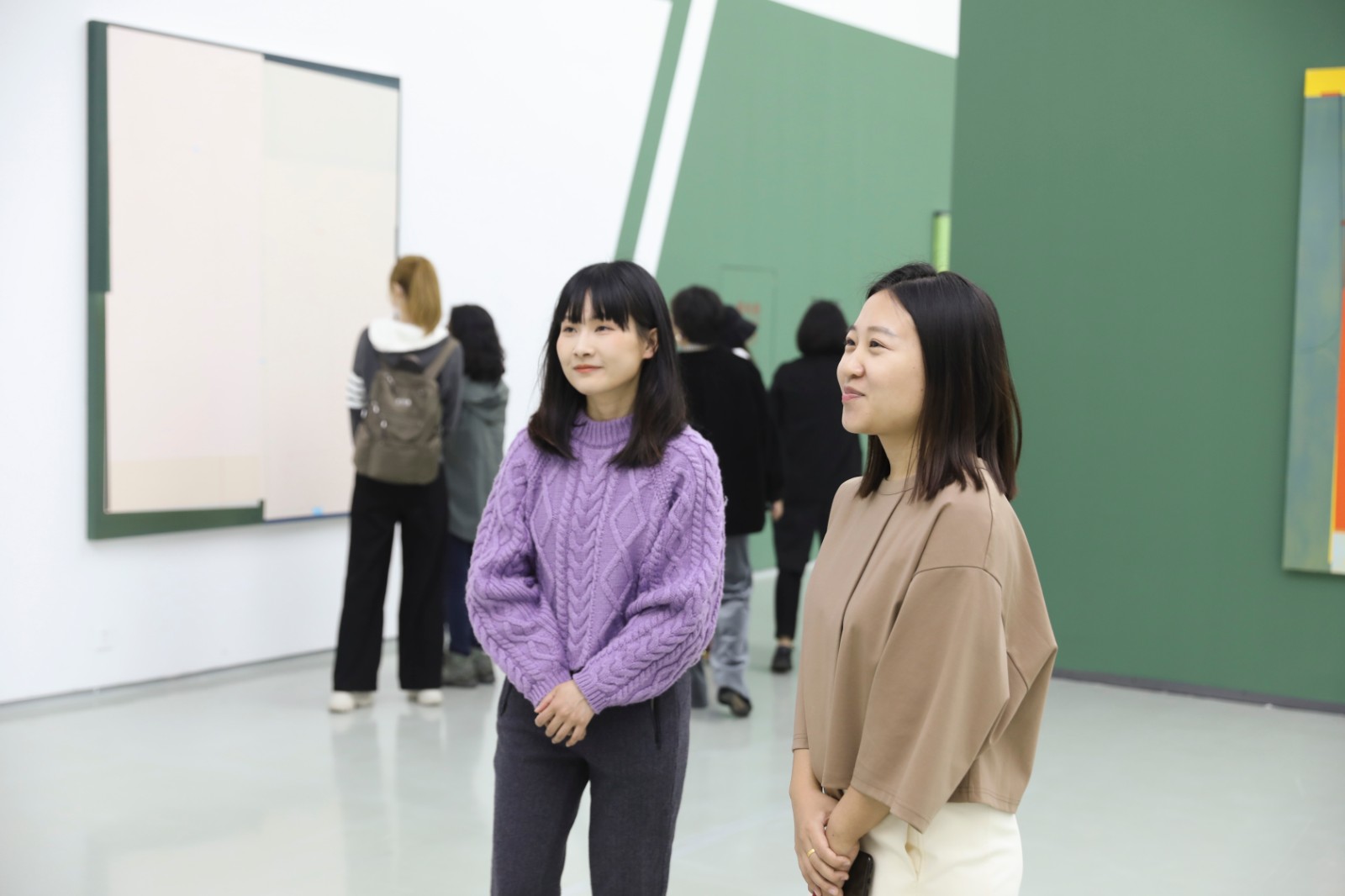 Curator Zhao Xiaodan and Artist Qian Jiahua at the Opening Ceremony
Curator Zhao Xiaodan and Artist Qian Jiahua at the Opening Ceremony
Qian Jiahua is a person who pursues romance but stays uninvolved at the same time. She sees painting and art-making as an extraordinary experience, during which her inner fantasy and external experiences blend in moments of inspiration. The scenery in the distance has been jammed into the center of the picture by the artist from an overhead perspective. A certain contingency and a strong sense of compound ritual ceremonies can be sensed from the initially-designed color blocks, which at the same time direct later images to where they belong. Like an amazing TV series, this logic leaves suspense at every twist. In the contemplation of contingency and inevitability, fragments of thoughts emerge as separate works. We are like the Purple Witch who is curious how the Scarlet Witch has acquired the ability to modify reality, or like the S.W.O.R.D that has made its way into the world step by step based on Wanda’s intermittent messages and images. The information revealed intermittently according to the works we see and get is like an image captured outside this logic whose interior lies in a whole world. It seems that we can never see the full picture of this space of groups, classes or crowds, which has been continually folded and occasionally surfaced due to incidents. It only exists by the perception of surface information. This creative process is somehow parallel to how we shape the visible and how we mask the invisible.
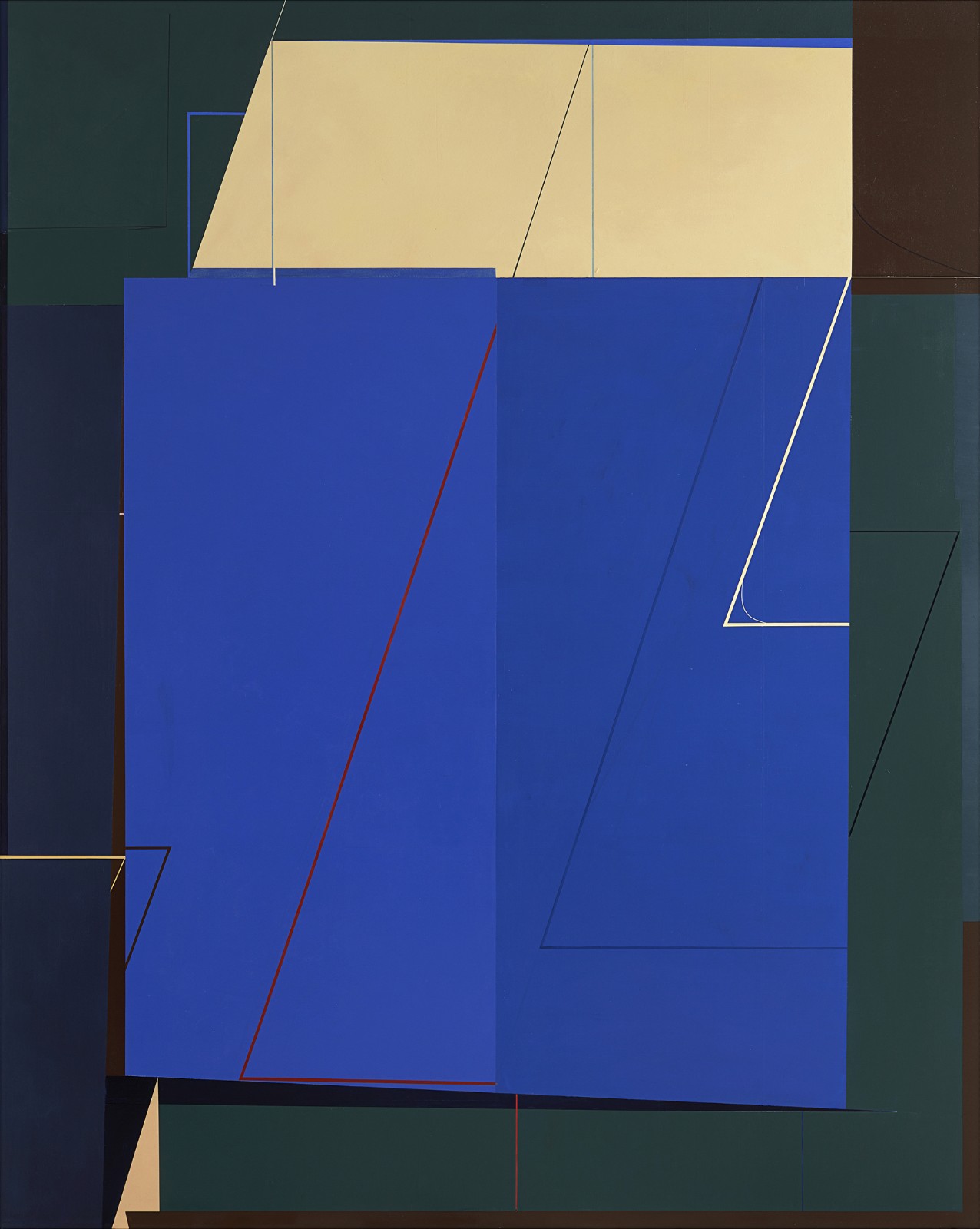
Soundproof, 2019-2021, Acrylic on canvas , 250×200cm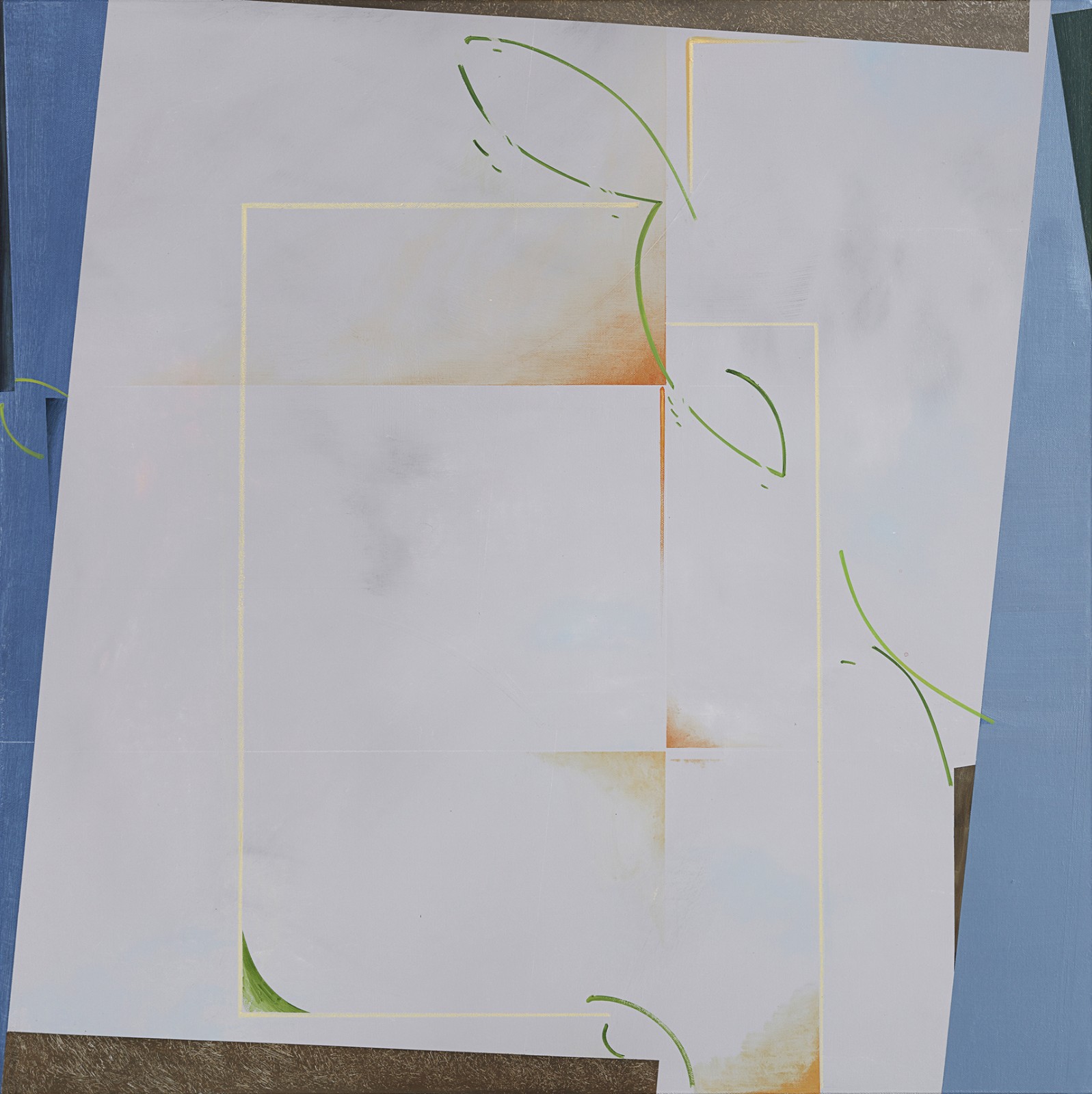
Aluminum and Plant, 2020, Acrylic on canvas, 100×100cm
The fairyland and dreamland created by magic are essentially a protection mechanism. In the artist’s fantasy, the light and graceful strokes and the seemingly calming colors both imply a resistance to solidified hierarchy and the sense of artificial order: Personal information collected and pried into has become commodities of a major part of the consumption chain; Push notifications in search engines may be completely different among people taking skepticism and conspiracy theories... Humans have become the individuals shaped and surrounded by information that can easily be deemed as the so-called truth by the superficial cognition of a single individual or a class since the information can be manipulated or tampered with. Thus, the behavior patterns of these classes and crowds continue to be shaped by the information. The real world is a model, and there is not much chance that we can travel through different classes and see all the truth.
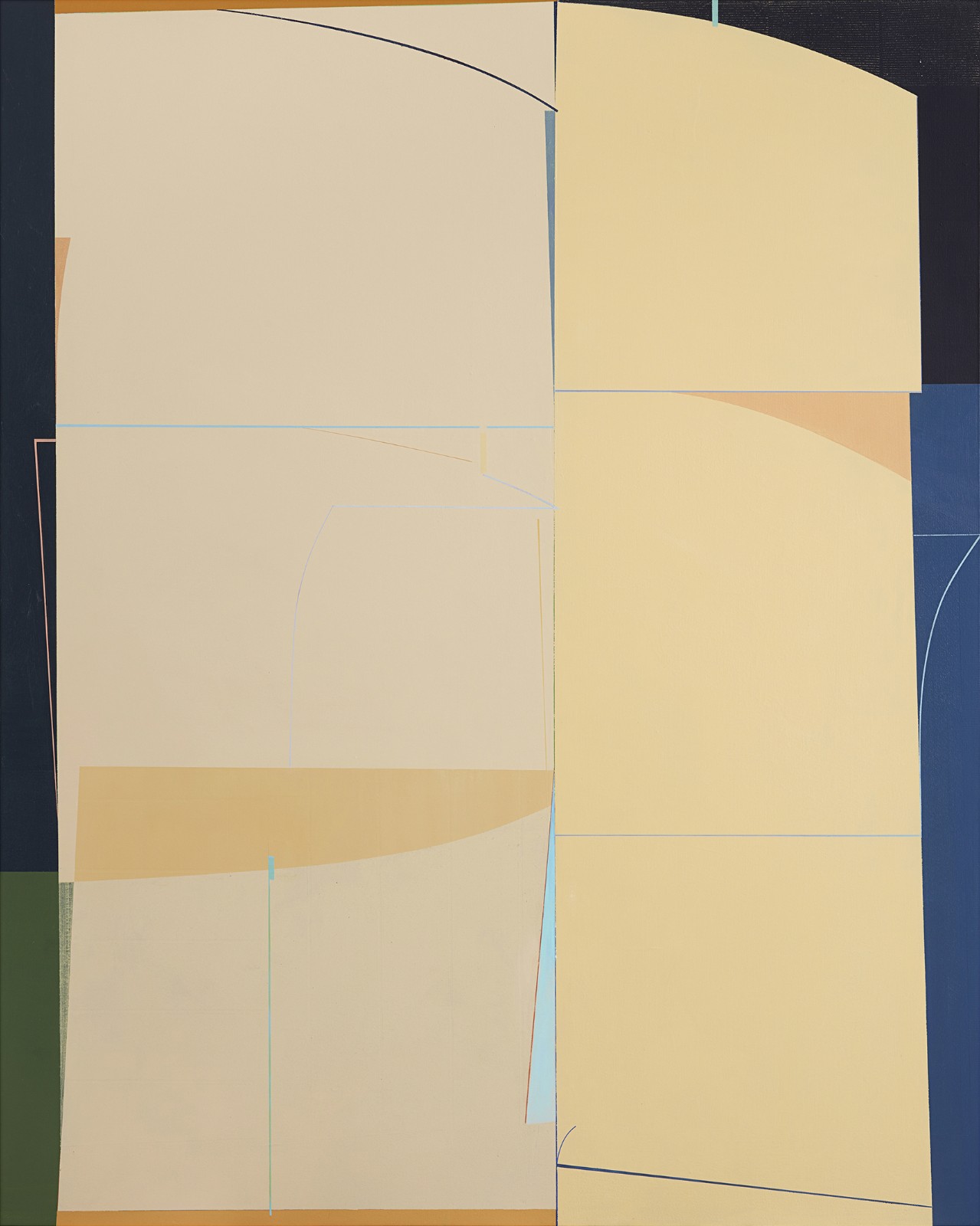
Sunrise, 2019-2020, Acrylic on canvas, 200×160cm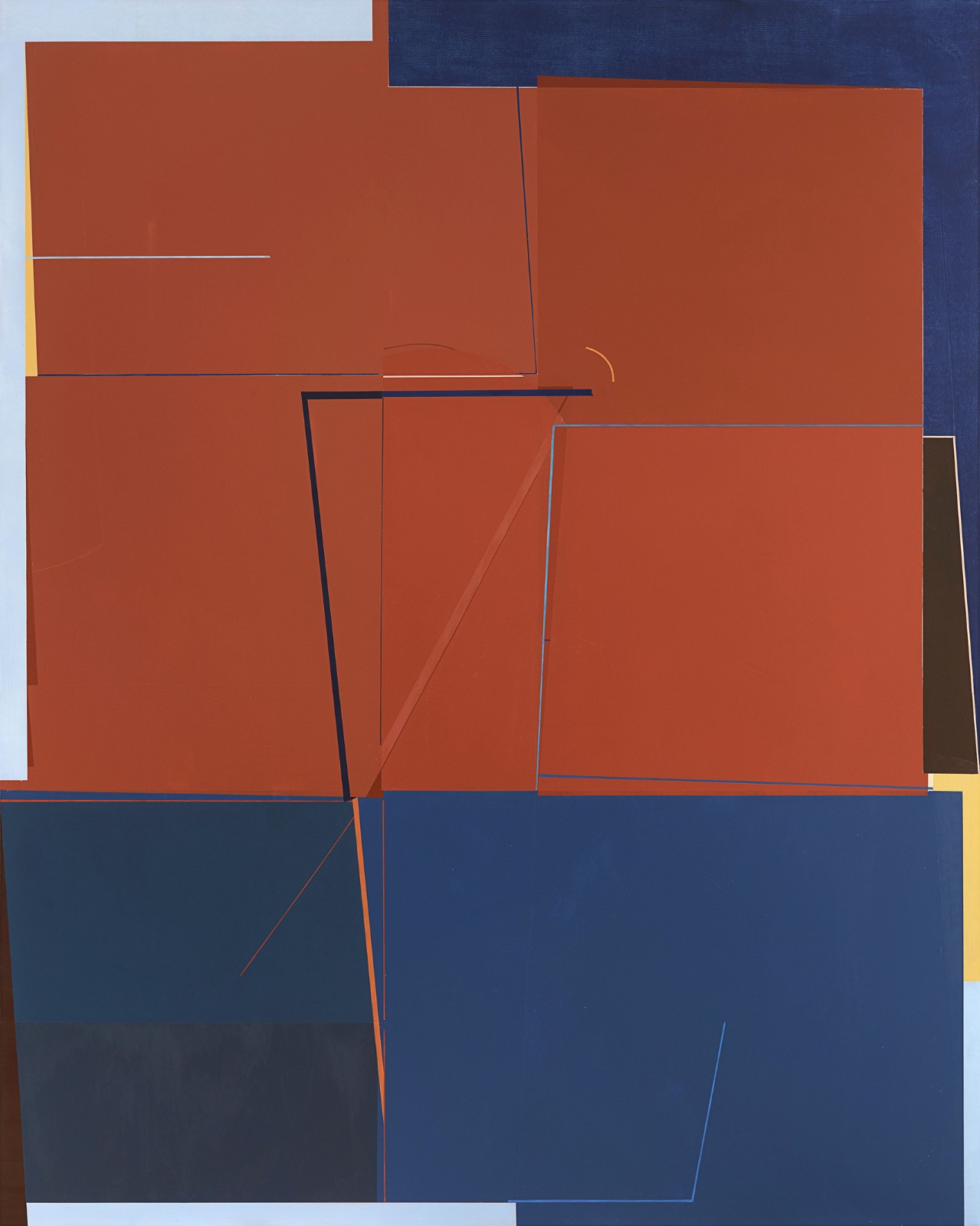
Solar Eclipse, 2019-2020, Acrylic on canvas, 250×200cm
How the exhibits are arranged can be seen as a pictorial and structural extension of the work. On the right side of the exhibition hall, the three separated blue-gray walls and the warm light yellow color in between create an illusion of light and shadow. Especially when the three walls are outlined, they look as if they had been peeled off the exhibition wall. The flooring parallel to the blue-gray walls and the warm light yellow walls have been laid opposite the right section of the hall, whose color matches the warm light yellow as if elongating the light and shadow. Additionally, the several-square-meter flooring is a few millimeters higher than the ground. With its texture, it can touch your soft heart unexpectedly the moment you step onto it. On the left side of the hall, the structures tell another story. The room with the green screen conveys the whispers of the artist. They may be visible symbols or obscure incantations. Moving forward, a genuine emotion can be felt drifting in the green color and the twisted-leaflike floor tiles that protrude from the ground. Walking in these two diagonally spliced exhibition halls, one may feel lost in thought for a few seconds or longer, picturing another story in mind and connecting to that space. When you come back to the scene, your body and soul reunite as one. Probably this is when we can step into the artist’s world, basking in the afterglow of her romantic thoughts so that we can distance ourselves from reality and go into hiding for the present.
About the exhibition
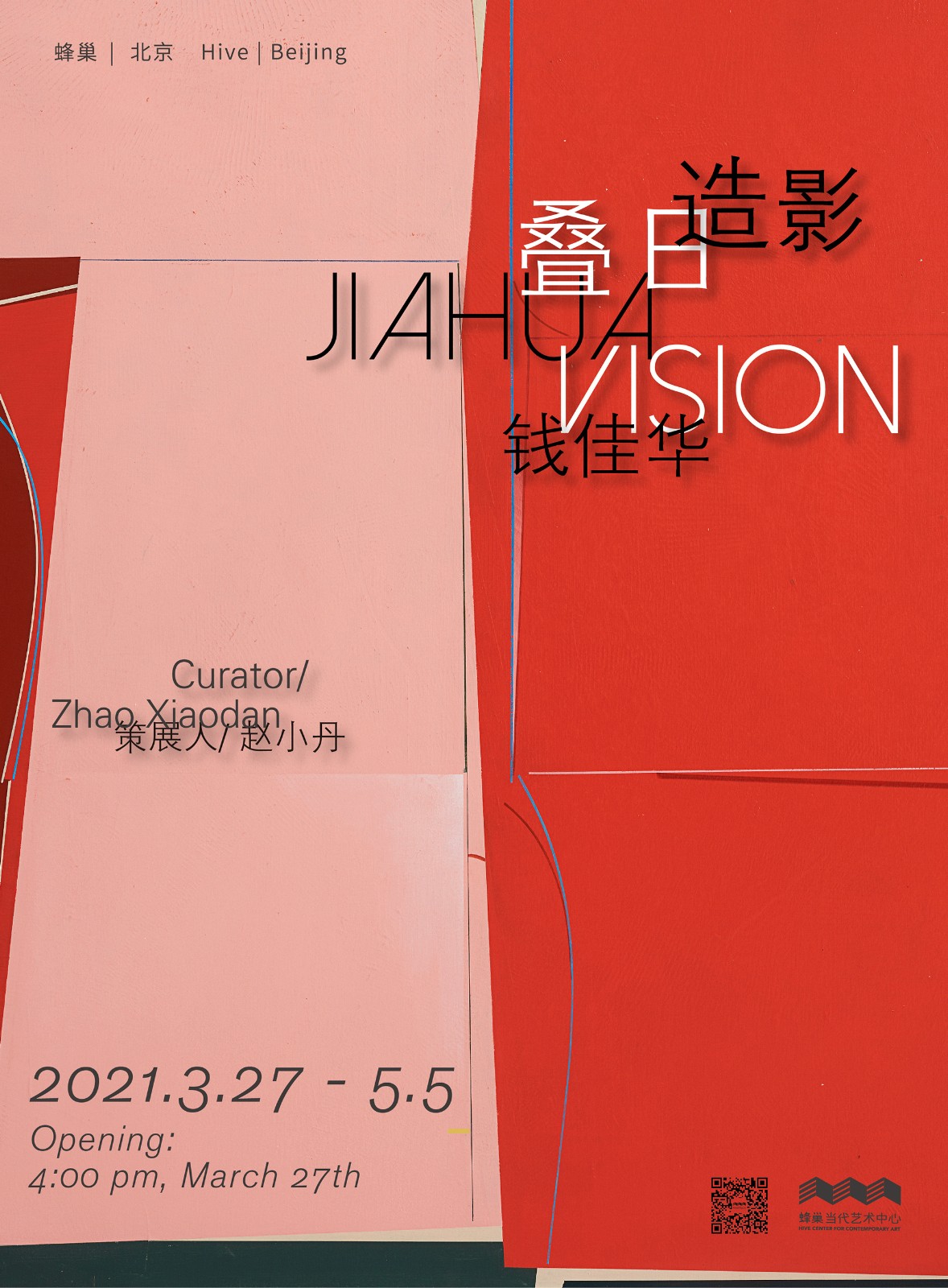
Curator: Zhao Xiaodan
Opening: 2021.3.27
Exhibition Dates: 2021.3.27 - 2021.5.5
Venue: Hive Center for Contemporary Art (Beijing)
Address: E06, 798 Art District, Chaoyang District, Beijing, China
Aspartime as a Statement
By Yu Fei
In the last month of 2020 which has just gone, Aspartime finally made a comeback, after around three years of keeping a low profile for self-enrichment, with their latest art project “ZigZag”. As suggested by every previous project that marks the start of every stage of their art, they are never afraid to take a new path and start anew. This time is no exception: they dove without hesitation into the art trend of sculpture after bidding farewell to the “Taobao Project” of selling ideas for two yuan per idea and the “ké” Project of making cases for ephemeral GIFs.
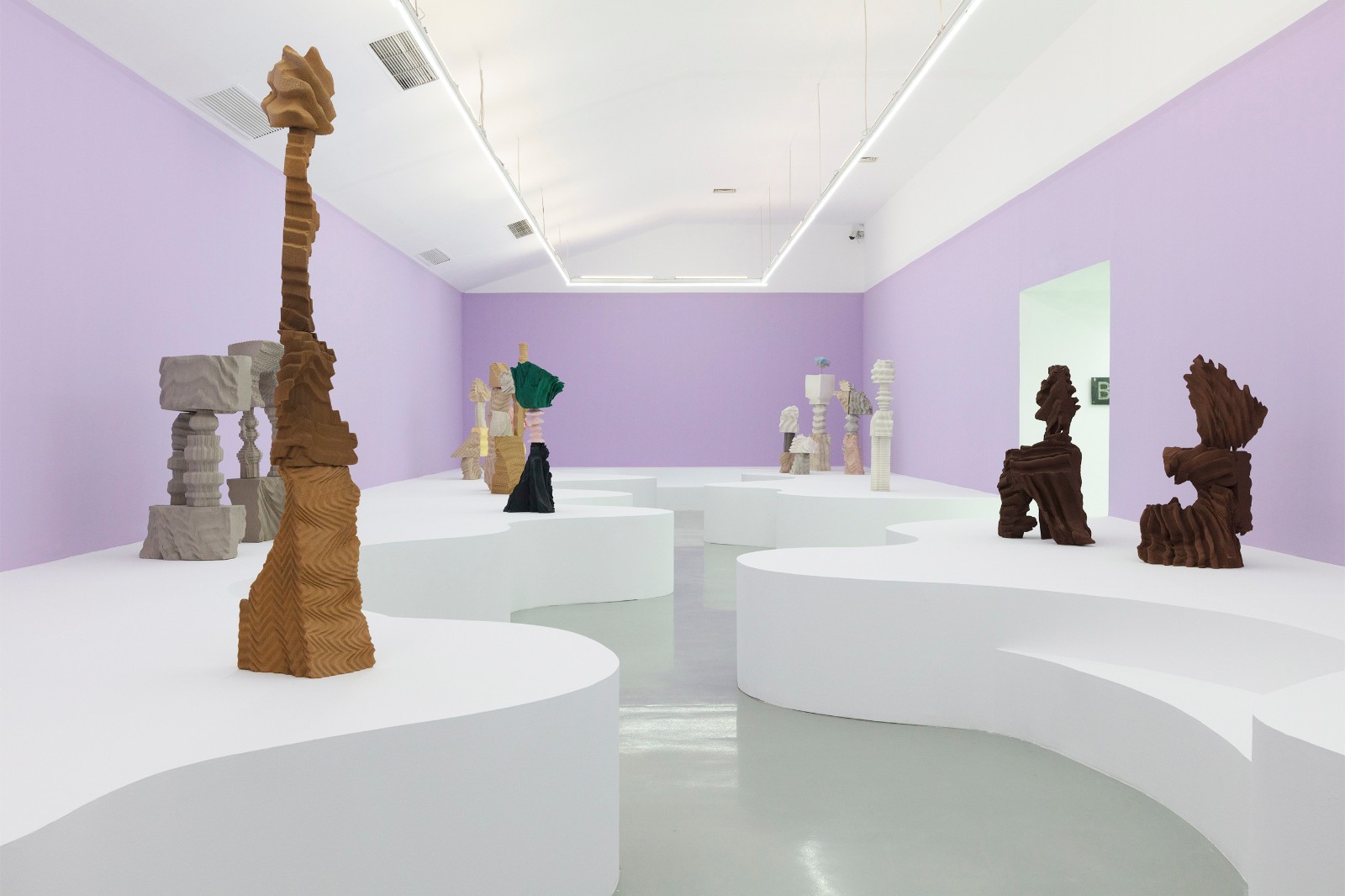
Exhibition View of "Rose is a rose is a rose is a rose"
With the readiness to disenchant the audience with the mystery of art as usual, Aspartime disclosed frankly the material and tool for their sculptures: Styrofoam and electric heating wire. Aspartime’s approach to sculpture, a medium of art with a profound history, may seem too straightforward and plain, but they happen to be good at discovering the unusualness of something usual, the unsimplicity of something simple. If Styrofoam is “the unbearable lightness of being”, electric heating wire could make “all that is solid melt into air”.
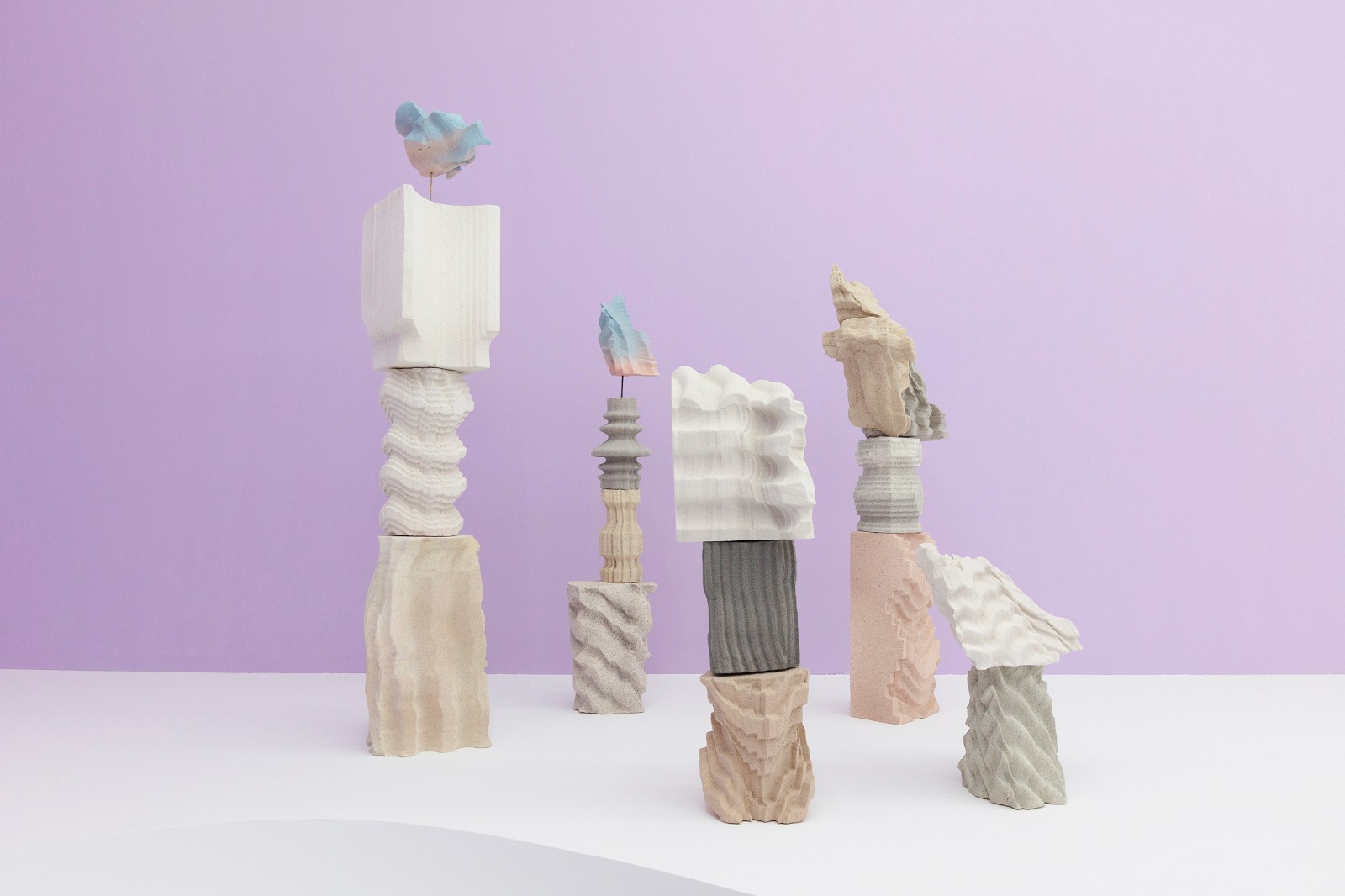
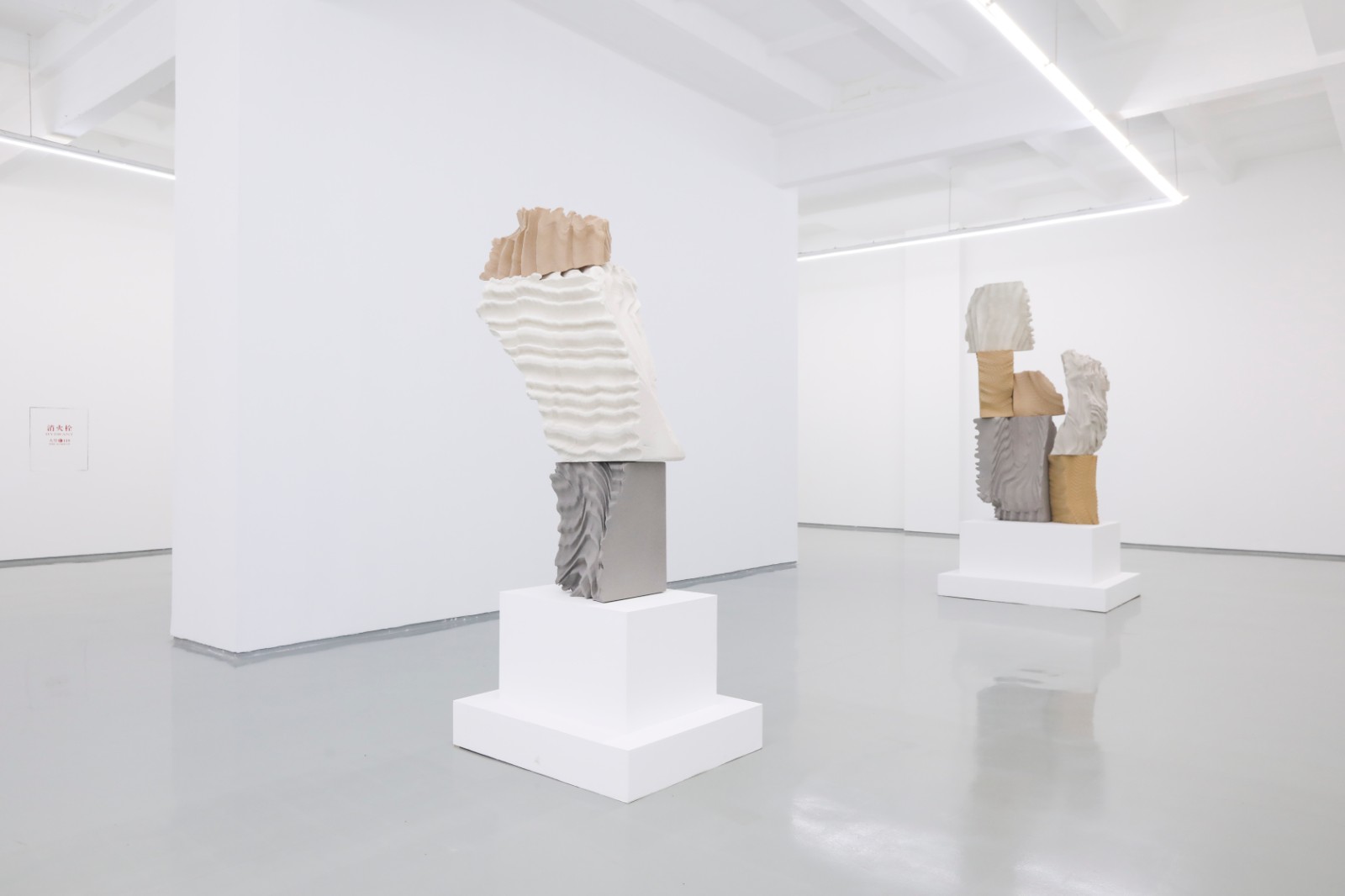
Exhibition View of "Rose is a rose is a rose is a rose"
High plasticity, a phrase of great praise for an individual, happens to be a precious characteristic of Styrofoam. The electric heating wire plays the role of a soft and sharp brush, thus enabling Aspartime to sketch freely on three-dimensional material, with no design of any concrete figure beforehand but only self-forgetting rhythmic reshaping of the material. Soon scraps of the white foam are being cut out during the improvisation and taking up the empty space of their house. Like huge shells being washed up by sea waves, Aspartime pieces up step by step various unexpected yet reasonable shapes based on their fortuitous appearances with a sense of déjà vu. Then, they coat the white foam all over with real stone paint which imitates the texture and luster of natural stone, until it seems to become a new substance on the surface.
In such a process, the group of sculptures built on white Styrofoam seems to constitute a cultural and natural landscape: they could be dunes or crags, or lost civilization or ruins of an old city, or totems of primitive tribes or modernist designs, or they could be the mixture of all of the above, an all-inclusive monument that has survived a reconstruction. The appeal of these sculptures also lies in the invisible, intangible hands hidden beyond the figures, which might be the sandstorm, flow of water or time. In his A Story of Ruins, Wu Hung mentions the subtle meaning of “trace” (ji) in ancient Chinese: “when someone is searching for traces of the past, he also leaves his own footprints along the way”. These sculptures are like pearls lost in the ocean stained with the Aspartime tone on an unconscious journey of archaeology.
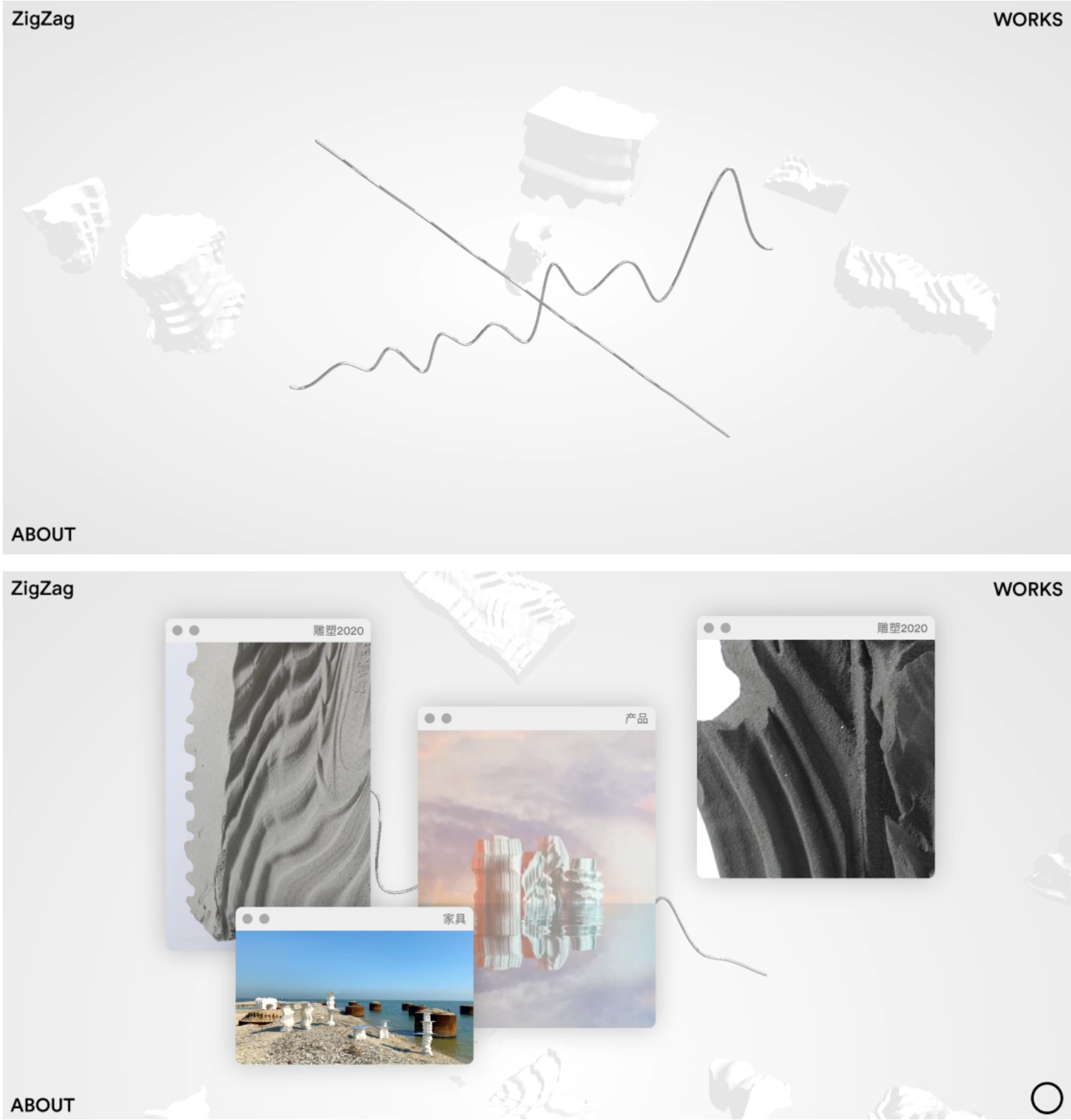
ZigZag, Online Display by Aspartime
Impressive for its plasticity, lightness and artlessness, foam has become a frequently-used art medium of Aspartime. It’s foreseeable that, in the near future, they might go for another tool of modeling, or another paint for disguising, but foam would still be the constant protagonist at the center of their art practice. This is understandable. Since the 1960s, there have been a good number of sculptors in the West who favor the use of “ephemeral material” and would even employ the “waste” of the consumer society for the main body of their sculpture. Unnoticeably, Aspartime has a different understanding than these predecessors: though being discarded constantly from industrial manufacture and artistic processing, Styrofoam is still highly irreplaceable as a matter of fact. Without the moulds made of Styrofoam, it’d be impossible to give shape to the materials which are regarded as more important, of higher quality and as more valuable.
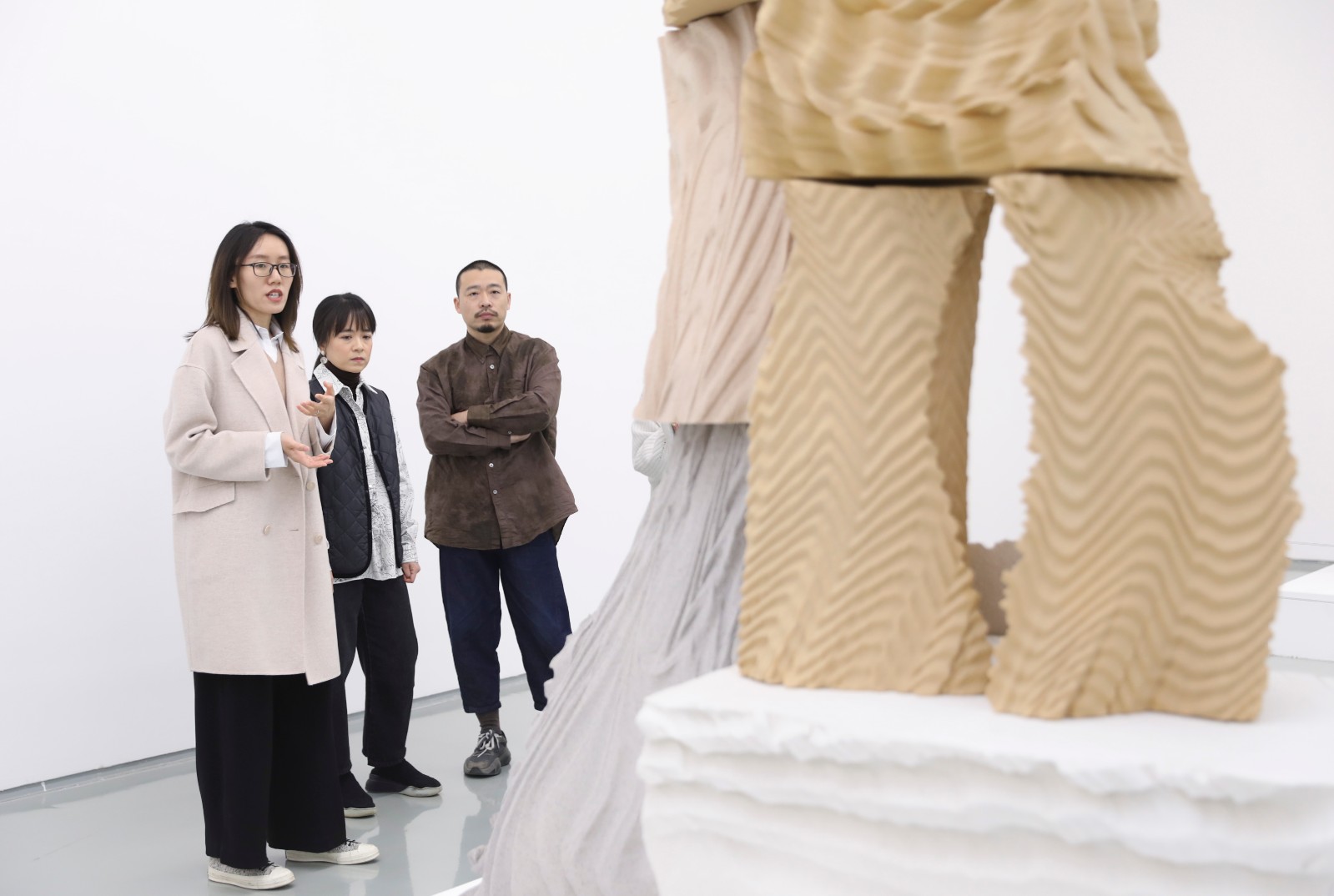
Curator Yu Fei and Artists of Aspartime at the Exhibition Venue
Hence such a miracle: Styrofoam, often used as a substitute, has become a truly unique material, and all the others, whose modeling relies on the help of a foamy body, have become a form of imitation of it. For example, besides the Styrofoam sculptures in their Zigzag series, Aspartime also used them as archetypes to make elaborate furniture and vases with well-selected material. They may have a longer life than foam, but they are always shadows of foam that are each built on a body of foam. Foam itself doesn’t denote or symbolize anything; it’s nothing but itself. Eventually, only foam is irreplaceable.
2487-2020-1-13-1, 2020, Foam block, stone paint, 30×90×100cm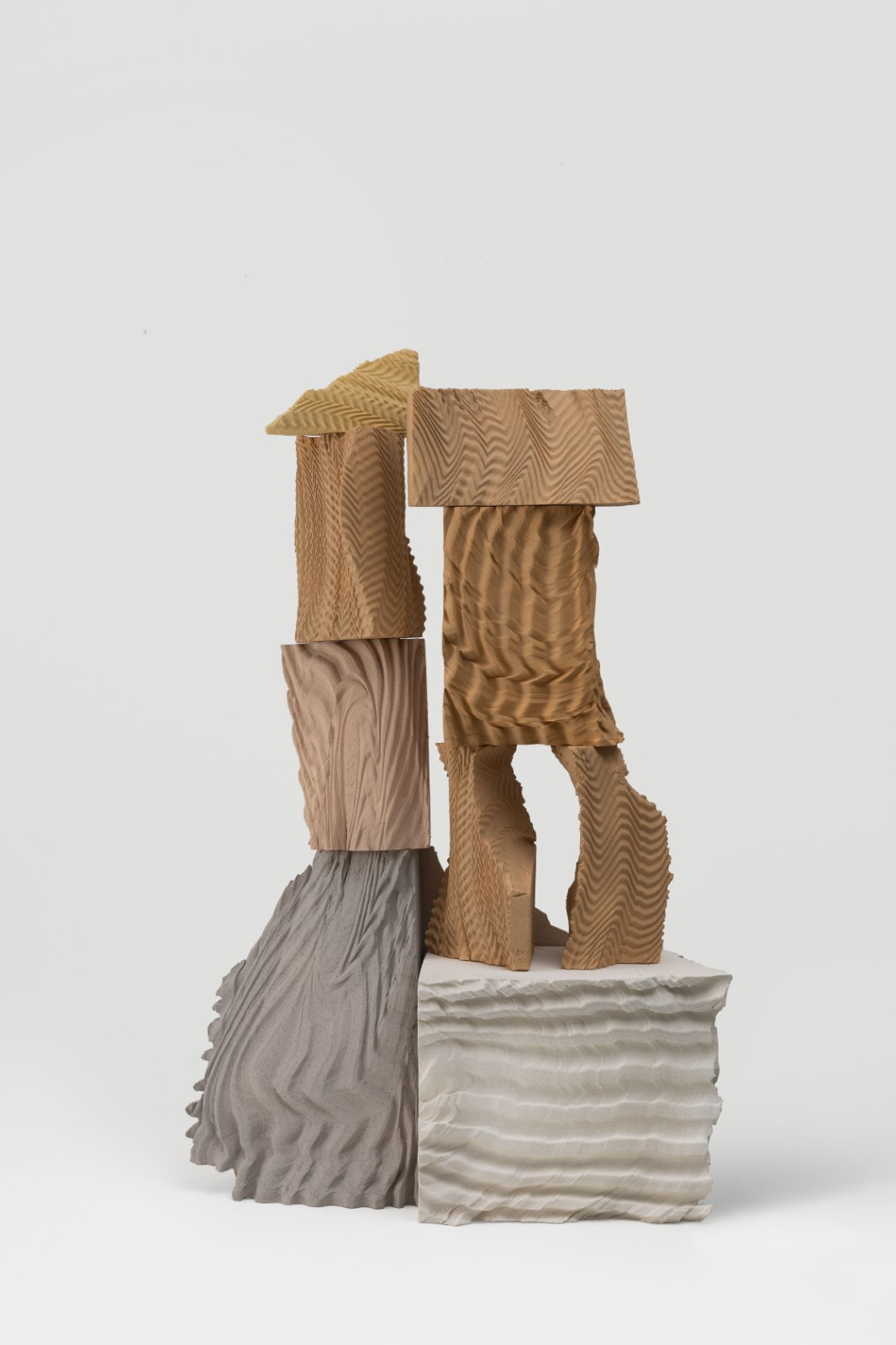
Despite Aspartime’s perspicacious employment, foam, in the eyes of the general public, is still the most common and characterless material in the corners of everyday production and life. Aspartime has developed a habit to feel compassion for seemingly insignificant things, and it’s just owing to their unusual empathy with foam, which they call a being of “unique mediocrity”, that they would profess their deepest feeling to foam through the time they spent on the sculptures and the efforts they made to put up the exhibition. And they rephrase foam with the famous quotation of Gertrude Stein, the mother of modernism – “Rose is a rose is a rose is a rose”. The signification that links the word to the object snugly and the feelings delivered through the rhythm are both obvious. May roses never fade, and may foam last forever.
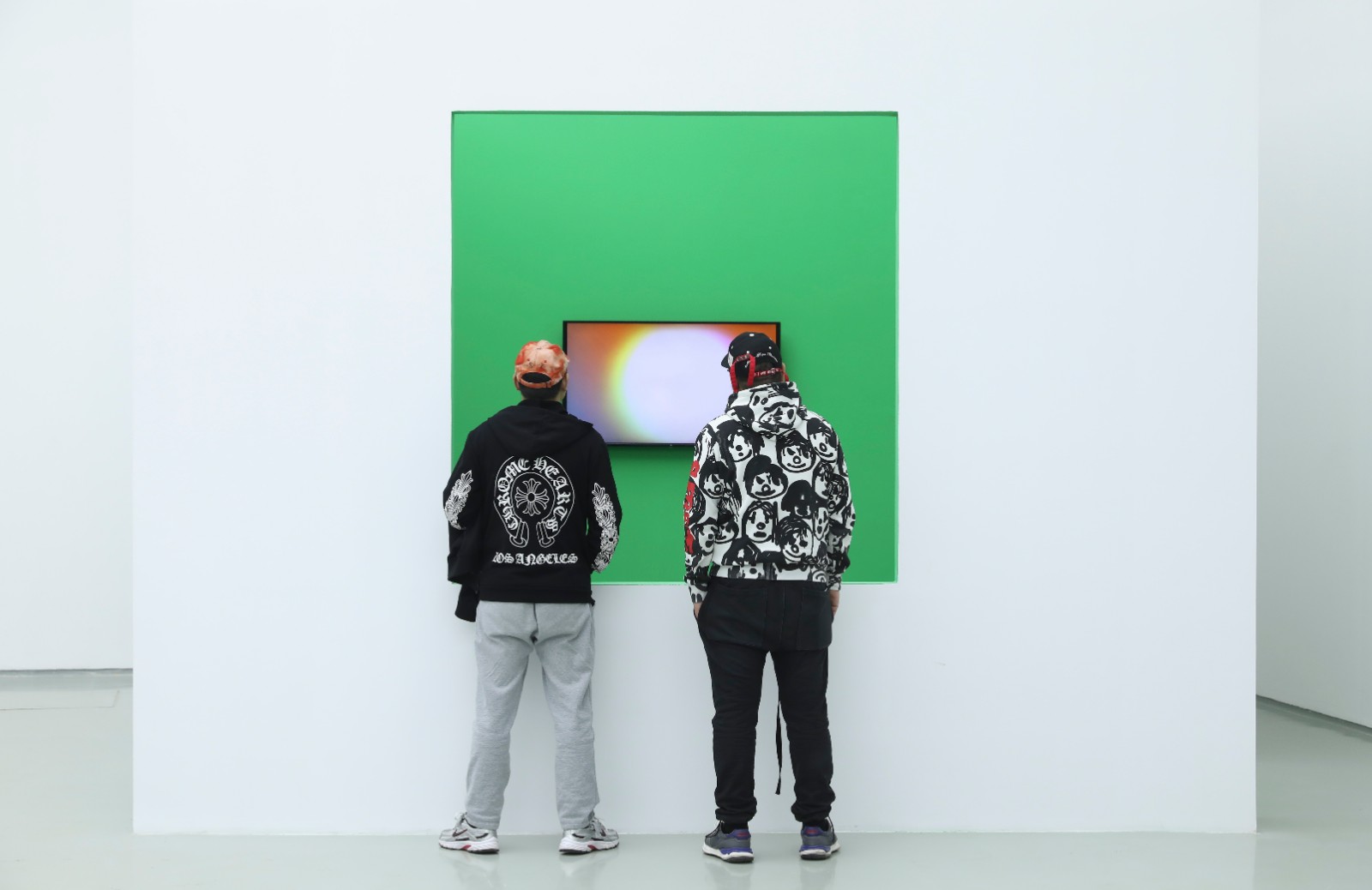
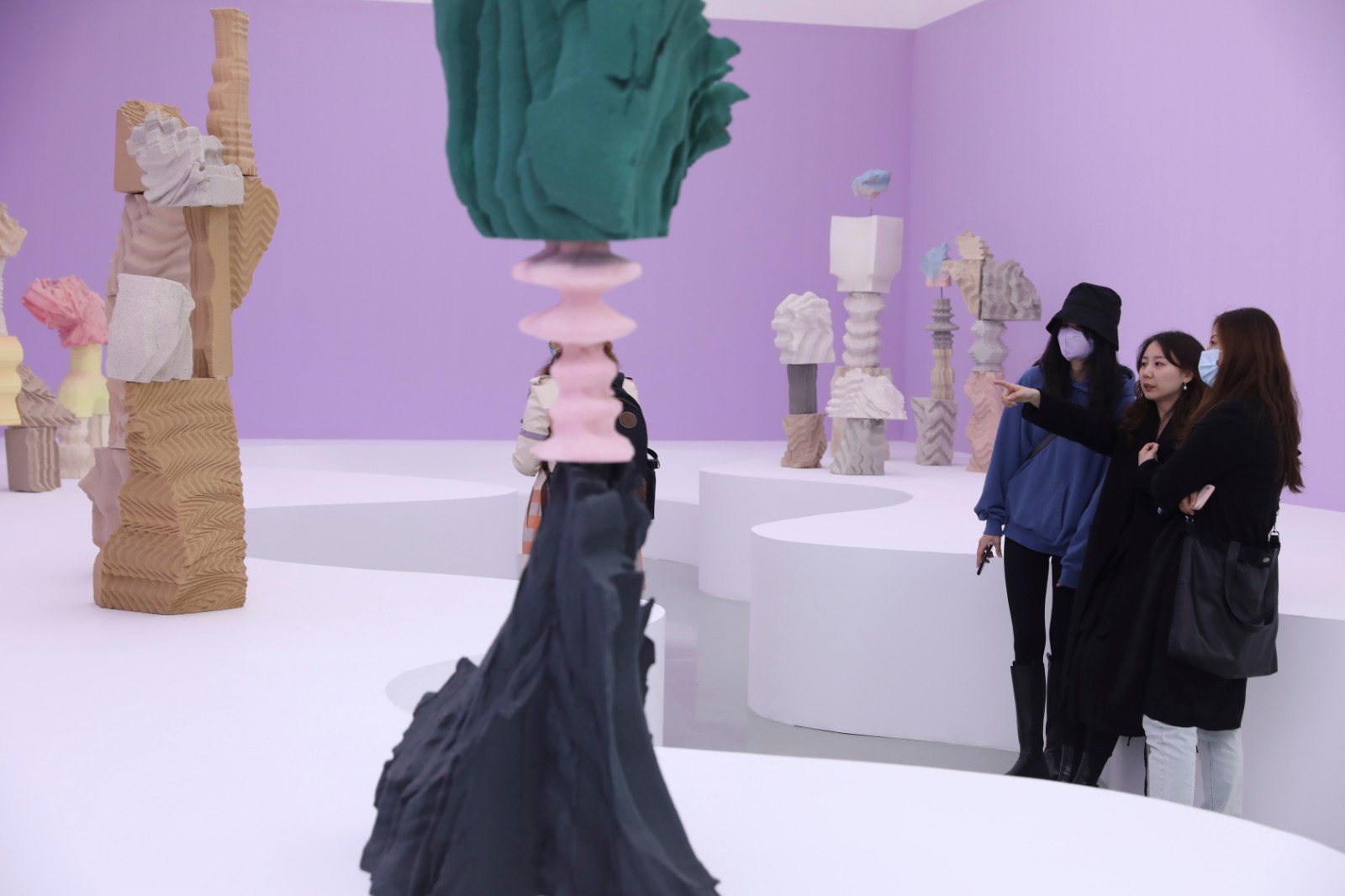
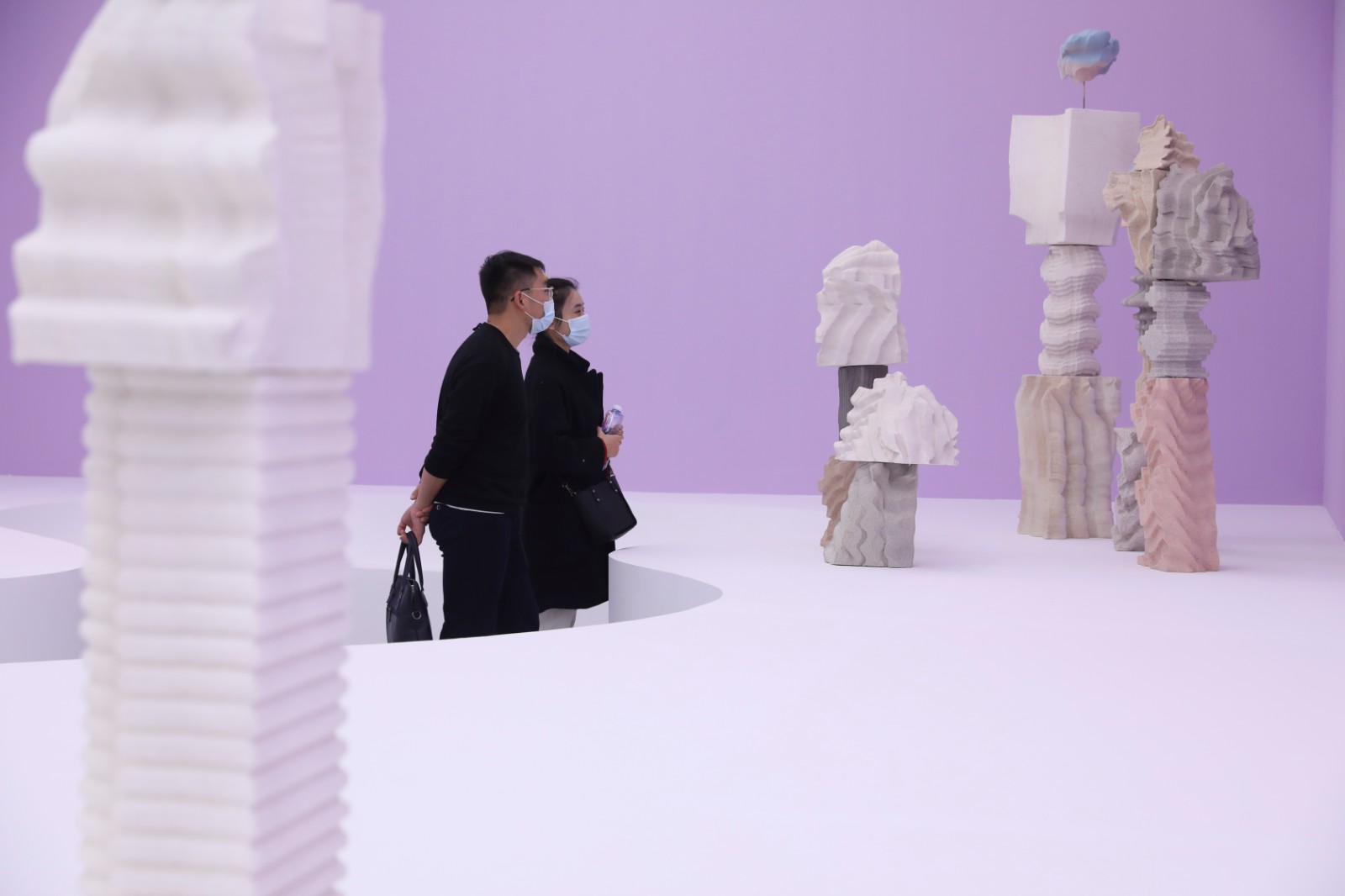
Exhibition View of "Rose is a rose is a rose is a rose"
“We are making foam perpetual” is a sentence by Aspartime on their personal website, which can be construed as their justification of short-lived, ephemeral, ordinary things. Certainly there’s no absolute perpetuity in the world but only romantic imagination about it, as suggested by the motive for their name “Aspartime”: it symbolizes the ubiquitous sugar-substitute sweetener and part-time-like soul with the freedom to create; the philosophy of life and attitude to art hidden in this are more a silent statement of theirs. They always like to challenge some established modes of thinking and art trends by keeping their philosophy intact. In this age where crypto art is thriving, Aspartime, a native of this Internet age, is now becoming more and more active in offline practice; and as people are now getting used to the hands of artists being replaced by machines and manpower, Aspartime is addicted to pure handwork and has developed an indefatigable love. As in Slavoj Zizek’s interpretation of the intimate relationship in the context of COVID-19 – “bodily contact is a path to spirituality”, Aspartime has also chosen to get closer to their work when distance and efficiency are priority concerns in current times.
About the exhibition
Curator: Yu Fei
Opening: 2021.3.27 16:00
Exhibition Dates: 2021.3.27-2021.5.5
Venue: Hive Center for Contemporary Art (Beijing)
Address: E06, 798 Art District, Chaoyang District, Beijing, China
Courtesy of the Artists and Hive Center for Contemporary Art.


